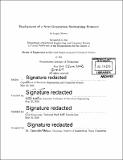Deployment of a next generation networking protocol
Author(s)
Mercer, Logan (Logan James McClure)
DownloadFull printable version (13.13Mb)
Other Contributors
Massachusetts Institute of Technology. Department of Electrical Engineering and Computer Science.
Advisor
Tomas Palacios and Greg Kuperman.
Terms of use
Metadata
Show full item recordAbstract
This thesis presents experimental verification of the performance of Group Centric Networking (GCN), a next generation networking protocol developed for robust and scalable communications in lossy networks where users are localized to geographic areas, such as military tactical networks. In previous work, initial simulations in NS3 showed that GCN offers high delivery with low network overhead in the presence of high packet loss and high mobility. We extend this prior work to verify GCN's performance in actual over-the-air experimentation. In the experiments, we deployed GCN on a 90-node Android phone test bed that was distributed across an office building, allowing us to evaluate its performance over-the-air on real-world hardware in a realistic environment. GCN's performance is compared against multiple popular wireless routing protocols, which we also run on our testbed. These tests yield two notable results: (1) the seemingly benign environment of an office is in fact quite lossy, with high packet error rates between users that are geographically close to one another, and (2) that GCN does indeed offer high delivery with low network overhead, which is in contrast to traditional wireless routing schemes that offer either high delivery or low overhead, or sometimes neither.
Description
Thesis: M. Eng., Massachusetts Institute of Technology, Department of Electrical Engineering and Computer Science, June 2016. Cataloged from PDF version of thesis. "May 2016." Includes bibliographical references (pages 72-73).
Date issued
2016Department
Massachusetts Institute of Technology. Department of Electrical Engineering and Computer SciencePublisher
Massachusetts Institute of Technology
Keywords
Electrical Engineering and Computer Science.